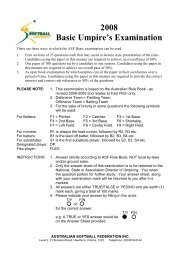2012 Annual Report - Softball Australia
2012 Annual Report - Softball Australia
2012 Annual Report - Softball Australia
Create successful ePaper yourself
Turn your PDF publications into a flip-book with our unique Google optimized e-Paper software.
Community Participation<br />
Community Participation<br />
<strong>Softball</strong> <strong>Australia</strong> is committed to expanding <strong>Softball</strong> programs in targeted urban, rural and remote areas across<br />
<strong>Australia</strong>.<br />
Indigenous <strong>Softball</strong> Program<br />
<strong>Softball</strong> <strong>Australia</strong> and our Member States have a long<br />
and proud history of promoting and delivering <strong>Softball</strong><br />
to Indigenous Communities. Our Indigenous <strong>Softball</strong><br />
Program produces positive health and social outcomes<br />
by providing female and male Indigenous <strong>Australia</strong>ns of<br />
all ages and abilities with opportunities to participate<br />
in <strong>Softball</strong> – as players, coaches, umpires,<br />
administrators and volunteers. With <strong>Softball</strong> generally<br />
recognised as the preferred sport of Indigenous<br />
women, and becoming increasingly popular amongst<br />
Indigenous men, we are committed to expanding<br />
<strong>Softball</strong> programs in targeted urban, rural and remote<br />
areas across <strong>Australia</strong>.<br />
The purpose of the program is to increase participation<br />
of Indigenous <strong>Australia</strong>ns from targeted urban, rural<br />
and remote areas in all facets and levels of <strong>Softball</strong> by:<br />
• embedding <strong>Softball</strong> as the sport of choice for<br />
Indigenous women<br />
• positioning <strong>Softball</strong> as an attractive option for<br />
Indigenous men<br />
• supporting government health and wider policy<br />
objectives<br />
• working with Indigenous communities to help them<br />
become self-sufficient, so they can continue to<br />
develop and deliver their own events and programs.<br />
A bat, painted by Angelina Doolan and a ball, painted<br />
by Kira Briscoe, students from the Worawa Aboriginal<br />
College, Healesville, Victoria, were presented by<br />
<strong>Softball</strong> <strong>Australia</strong> Director, Helen Langenberg, to<br />
Andrew Leigh Federal Member for Fraser and Phil<br />
Borgeaud, Deputy Director, Strategy and Relations,<br />
<strong>Australia</strong>n Institute of Sport.<br />
2011/12 ISP facts<br />
• 7,870 participants involved in Indigenous <strong>Softball</strong><br />
Program activities<br />
• 150 <strong>Softball</strong> Program activities delivered<br />
• 150 participants involved in managing <strong>Softball</strong><br />
programs and competitions<br />
• 160 participants completed coaching/officiating<br />
accredited training<br />
• 100 participants with a disability involved in<br />
Indigenous <strong>Softball</strong> Program activities<br />
<strong>Softball</strong> <strong>Australia</strong> officially launched the Indigenous<br />
<strong>Softball</strong> Program Strategy in Canberra on 23 March<br />
<strong>2012</strong>. Dignitaries were treated to an exhibition match<br />
involving players from the WhISPers <strong>Softball</strong> Club and<br />
Indigenous players from NSW. Ngunnawal Indigenous<br />
elder, Agnes Shea, delivered a welcome to country<br />
speech, acknowledging the players who participated in<br />
the Exhibition match, and <strong>Softball</strong> <strong>Australia</strong>’s<br />
Indigenous role models, Stacey Porter, Vanessa Stokes<br />
and Jeff Goolagong.<br />
SOFTBALL AUSTRALIA ANNUAL REPORT <strong>2012</strong> Page | 54

















